
G.Skill Ripjaws KM780 RGB Review
Manufacturer: G.SkillUK price (as reviewed): Approx. £130-140 (inc VAT)
US price (as reviewed): $169.99 (ex Tax)
As you can probably tell from the name, the KM780 RGB has full RGB backlighting, something of a recent trend amongst high-end keyboards since the launch of Corsair’s K70 RGB last year. However, the KM780 RGB is the first keyboard we’ve seen since then to also use Cherry MX RGB switches, the rest having used Kailh or other alternatives. G.Skill’s keyboard is available with both Red and Brown switch types, and both can also be bought with standard Cherry MX switches and red backlighting instead of RGB for about $40 less (likely less than £100 in the UK).
The KM780 uses standard keycap sizes except on the bottom row, where the three to the left are larger than normal and the spacebar smaller as a result. Still, you should be able to replace most of them easily. You also get a set of 10 replacement keys as well as a keycap puller, which will also be useful for cleaning out crumbs and hairs. The replacement caps are for the typical gaming zone: Q, W, E, R, A, S, D, F, G and C are all included. They come in red and are textured, and the WASD ones are heavily contoured as well. This is very similar to what Corsair did in its Vengeance K60 keyboard. To be honest, we don't think much of them – the different shape and feel makes them very distracting when typing, and they didn't really bring any benefit for gaming either as the WASD is second nature anyway, as we suspect it will be to anyone who's considering spending this much on a keyboard.
This isn't the only area where G.Skill appears to have taken influence from Corsair in the design of the KM780, as like the K70 RGB it also has an aluminium faceplate and a detachable, soft-touch wrist rest. Even the shape of the dedicated media keys and aluminium volume wheel are very familiar. Still, Corsair is very successful when it comes to keyboards so it's hardly a poor choice of where to draw ideas from.
With its full key set, an additional column of six macro keys to the left, and sections that jut out on either side, the KM780 has a rather large desk footprint, especially once you attach the wrist rest, so users with limited desk space may want to measure up. Thankfully, the build quality is excellent. The aluminium plate and metal bar that runs around the outer frame make it truly rock solid. There's also a generous helping of rubber on the underside to keep it from slipping, though none is included on the rear legs.
The KM780 offers a full set of dedicated volume keys and a volume wheel, as well as an LED display below to show the current volume at a glance. This is a neat idea, but it's not actually in sync with the Windows volume level – if you adjust this manually, the LEDs do not change.
As with any keyboard with a similar design, the six dedicated macro keys can take some getting used to if you rarely look at your keyboard when typing – you may find yourself hitting one of them instead of Shift or Ctrl. Still, they do add some functionality even though almost every other key is programmable, allowing you to keep all keys at default but still have a wide range of macros or custom functions at your fingertips. We'll detail the software soon, but there's also an on-the-fly macro record button in the top left, and it's easy to use – simply press it once, select the key you want to program, hash out your macro and stop recording by pressing MR again. The three buttons next to MR are dedicated profile switch buttons, meaning you can have up to 18 macros in these six buttons alone.
The extra buttons don't stop there, as the KM780 is also equipped with a Windows lock key, brightness control (three levels of brightness are available, as well as off) and a timer key, the function of which is enabled and controlled through the software.
Round the back, we find a single USB pass-through port and dual audio jacks. Sadly, the port is not a USB 3 one, but it still could be useful for connecting peripherals. The result of these connectors is an extremely thick cable, though only one USB connection is required for all keyboard functionality, unlike the K70 RGB where it's two. Thankfully, the cable is braided well and feels secure at the connection. Lastly, there's also a switch which we eventually discovered is used to switch the board from n-key rollover to six-key rollover, presumably for certain legacy functions (and also something we've seen from Corsair before).
The last thing to note hardware wise is the mouse cable holder, which is fixed to the metal bar at the back. This is a neat idea and potentially useful for preventing cable drag by keeping your mouse wire elevated.

MSI MPG Velox 100R Chassis Review
October 14 2021 | 15:04

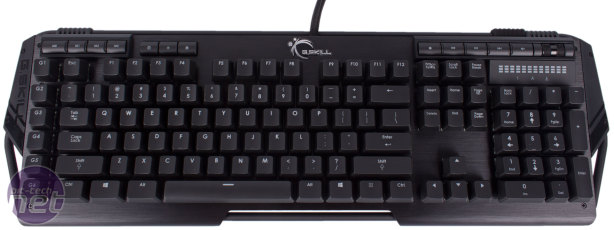
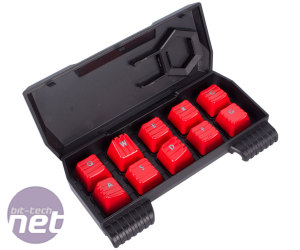
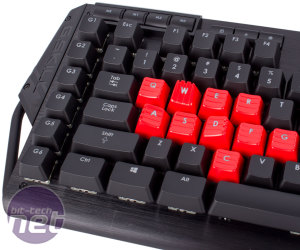
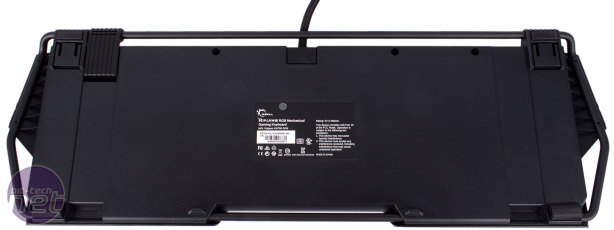
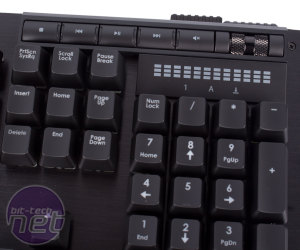

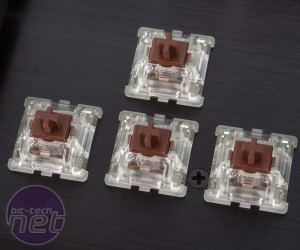
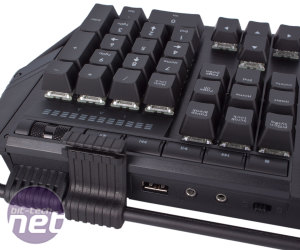







Want to comment? Please log in.